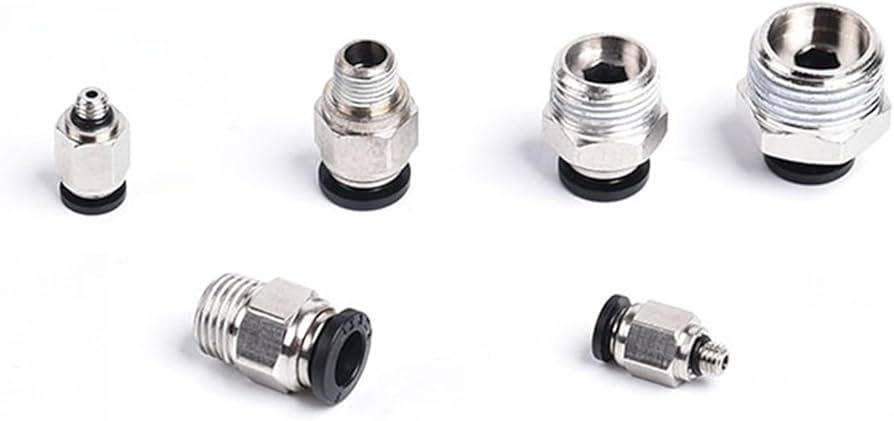Different Types of Female Fittings: Threaded, Flanged, and More

Female fittings are essential components in piping systems, used to create secure connections between pipes or tubes. These fittings are designed with internal threads or other connection types, allowing them to connect with male fittings or other types of fittings. There are several types of female fittings, each designed for specific purposes. In this blog, we will explore the most common types of female fittings: threaded, flanged, and more.
1. Threaded Female Fittings
Threaded female fittings are the most common type. They have internal threads that allow them to screw onto male fittings, creating a tight, leak-proof connection. These fittings are widely used in plumbing, gas lines, and industrial applications because they are easy to install and remove.
- How They Work: The internal threads of the female fitting match the external threads of a male fitting. When screwed together, the threads form a secure seal, preventing leaks.
- Common Uses: Threaded female fittings are commonly found in water pipes, gas lines, and oil systems. They are also used in both residential and industrial applications.
2. Flanged Female Fittings
Flanged female fittings have flat surfaces with holes that allow bolts to be used to secure the fitting to another flange. This type of connection is commonly used when the pipes need to be disconnected and reconnected frequently or when the system involves high-pressure conditions.
- How They Work: The flange is bolted to a matching flange on the male fitting or pipe. A gasket is often placed between the flanges to prevent leaks.
- Common Uses: Flanged female fittings are commonly used in large pipes and industrial applications, such as water treatment plants, chemical processing, and power plants. They are ideal for systems with high pressure or large diameters.
3. Compression Female Fittings
Compression female fittings are designed to provide a tight, secure connection without the need for threading. These fittings use a compression nut and a ferrule to create a seal when the fitting is tightened onto the pipe.
- How They Work: The compression nut is tightened, which compresses the ferrule (a small ring) around the pipe, forming a leak-proof seal. The compression fitting doesn’t require any threading or welding.
- Common Uses: These fittings are often used in plumbing, hydraulic systems, and refrigeration systems, where secure connections are needed without the complexity of threading.
4. Barbed Female Fittings
Barbed female fittings have small ridges or “barbs” on the inside of the fitting that help grip onto flexible tubing. These fittings are typically used in low-pressure systems or in applications where the pipes need to be connected quickly and easily.
- How They Work: The barbs grip onto the tubing when inserted, holding it tightly in place. A clamp is often used around the tubing to secure the connection.
- Common Uses: Barbed female fittings are commonly used in irrigation systems, air and water lines, and medical tubing connections. They are ideal for flexible, smaller diameter pipes.
5. Push-to-Connect Female Fittings
Push-to-connect female fittings, also known as push-fit fittings, allow pipes to be connected quickly and without the need for special tools. These fittings are designed to securely hold the pipe in place once it is pushed into the fitting.
- How They Work: When the pipe is pushed into the fitting, a series of internal seals grip the pipe, holding it in place. The connection is simple and can be easily disconnected if needed.
- Common Uses: Push-to-connect female fittings are often used in plumbing and air conditioning systems, providing a quick and easy way to make connections without needing threading or soldering.
6. Union Female Fittings
Union female fittings are designed to join two pipes while allowing easy disconnection if needed. They consist of a female fitting and a male fitting, which can be unscrewed to separate the connection.
- How They Work: The union consists of three parts: a female fitting, a male fitting, and a nut. When tightened, the nut holds the male and female fittings together, forming a secure connection. The nut can be unscrewed to easily disconnect the pipes.
- Common Uses: Union female fittings are commonly used in systems that require regular maintenance or changes, such as in water treatment systems or industrial piping.
Conclusion
Female fittings come in a variety of types, each designed to suit different needs and applications. Whether you’re working with threaded, flanged, compression, barbed, push-to-connect, or union female fittings, it’s essential to choose the right type for your system. Understanding the different options available can help ensure your piping system remains secure, leak-free, and efficient.
- Art
- Causes
- Crafts
- Dance
- Drinks
- Film
- Fitness
- Food
- Jocuri
- Gardening
- Health
- Home
- Literature
- Music
- Networking
- Alte
- Party
- Religion
- Shopping
- Sports
- Theater
- Wellness
- IT, Cloud, Software and Technology


